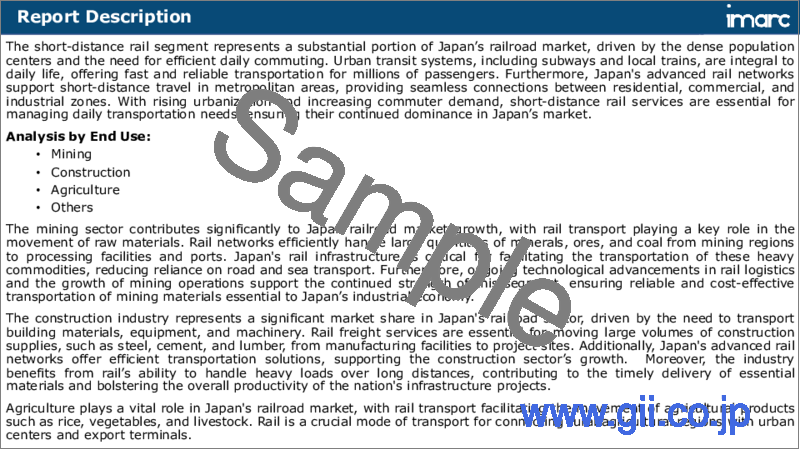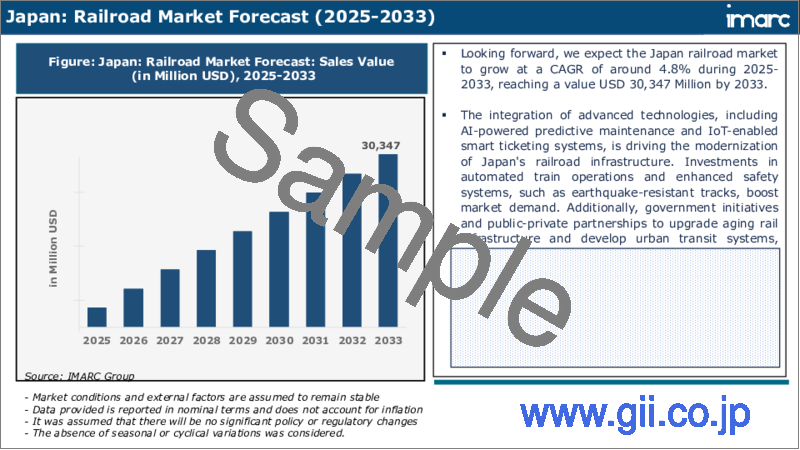|
|
市場調査レポート
商品コード
1609895
日本の鉄道市場レポート:タイプ別、距離別、最終用途別、地域別、2025年~2033年Japan Railroad Market Report by Type (Rail Freight, Passenger Rail), Distance (Long Distance, Short Distance), End Use (Mining, Construction, Agriculture, and Others), and Region 2025-2033 |
||||||
カスタマイズ可能
|
|||||||
| 日本の鉄道市場レポート:タイプ別、距離別、最終用途別、地域別、2025年~2033年 |
|
出版日: 2024年12月05日
発行: IMARC
ページ情報: 英文 116 Pages
納期: 5~7営業日
|
全表示
- 概要
- 目次
日本の鉄道市場の市場規模は2024年に199億米ドルに達しました。今後、IMARC Groupは、2033年には303億米ドルに達し、2025~2033年の成長率(CAGR)は4.8%になると予測しています。効率的で持続可能な輸送ソリューションに対する需要の増加、高度な信号・制御システム、自動化、デジタル技術のイントロダクション、国際貿易の拡大と世界化などが市場を牽引する主な要因です。
本レポートで扱う主な質問
- 日本の鉄道市場はこれまでどのように推移してきたか、また今後数年間はどのように推移するか?
- 日本の鉄道市場にCOVID-19が与えた影響は?
- 日本の鉄道市場のタイプ別の内訳は?
- 日本の鉄道市場の距離別の内訳は?
- 日本の鉄道市場の最終用途別の内訳は?
- 日本の鉄道市場のバリューチェーンにはどのような段階がありますか?
- 日本の鉄道市場の主な促進要因と課題は何か?
- 日本の鉄道市場の構造と主要プレーヤーは?
- 日本の鉄道市場の競合の程度は?
目次
第1章 序文
第2章 調査範囲と調査手法
- 調査の目的
- ステークホルダー
- データソース
- 市場推定
- 調査手法
第3章 エグゼクティブサマリー
第4章 日本の鉄道市場:イントロダクション
- 概要
- 市場力学
- 業界動向
- 競合情報
第5章 日本の鉄道市場情勢
- 過去および現在の市場動向(2019年~2024年)
- 市場予測(2025-2033)
第6章 日本の鉄道市場:タイプ別の内訳
- 鉄道貨物
- 旅客鉄道
第7章 日本の鉄道市場:距離別の内訳
- 長距離
- 近距離
第8章 日本の鉄道市場:最終用途別の内訳
- 鉱業
- 建設
- 農業
- その他
第9章 日本の鉄道市場:競合情勢
- 概要
- 市場構造
- 市場プレーヤーのポジショニング
- 主要成功戦略
- 競合ダッシュボード
- 企業評価象限
第10章 主要企業のプロファイル
第11章 日本の鉄道市場:業界分析
- 促進要因・抑制要因・機会
- ポーターのファイブフォース分析
- バリューチェーン分析
第12章 付録
The Japan railroad market size reached USD 19.9 Billion in 2024. Looking forward, IMARC Group expects the market to reach USD 30.3 Billion by 2033, exhibiting a growth rate (CAGR) of 4.8% during 2025-2033. The increasing demand for efficient and sustainable transportation solutions, the introduction of advanced signaling and control systems, automation, and digital technologies, and the growth of international trade and globalization are some of the key factors driving the market.
A railroad is a fixed track system designed for the transportation of passengers and freight using specialized vehicles, typically trains or locomotives. Railroads consist of interconnected tracks made of steel rails that provide a stable and smooth pathway for the movement of rolling stock. These transportation networks play a crucial role in facilitating efficient and cost-effective long-distance transportation, connecting cities, towns, and industrial centers. The advantages of rail transportation include high carrying capacity, lower environmental impact compared to other modes of transportation, and the ability to transport bulk goods efficiently. Additionally, it is highly cost-efficient, particularly for moving large quantities of freight over long distances as trains have a high carrying capacity and can transport goods in bulk, resulting in lower per-unit shipping costs compared to other modes of transportation.
Japan Railroad Market Trends:
The railroad market is driven by the increasing demand for efficient and sustainable transportation solutions. Railroads offer an environmentally friendly alternative to road transport, as they produce lower emissions and have higher energy efficiency, making them an attractive option for both passengers and freight transportation. Furthermore, population growth and urbanization play a crucial role in augmenting the railroad market. As cities expand and populations increase, there is a greater need for reliable and convenient transportation options to connect urban centers with suburbs and surrounding areas. Railroads provide an efficient means of mass transit for daily commuters, reducing traffic congestion and easing the strain on road infrastructure. Moreover, government investments and initiatives are significant drivers of the railroad market. Several countries and regions are investing in railway infrastructure to modernize existing networks and develop new high-speed rail corridors, thus creating a positive market outlook. Also, government support through funding, subsidies, and policy incentives encourages private and public entities to invest in railway projects, thereby propelling the market. Additionally, the growth of international trade and globalization is supporting the demand for freight transportation services provided by railroads since rail freight offers a cost-effective and reliable option for transporting goods over long distances, particularly for heavy and bulk commodities. Furthermore, as global supply chains become more interconnected, railroads play a vital role in facilitating the movement of goods between countries and regions. Besides, continual technological advancements and innovations are also shaping the railroad market as the introduction of advanced signaling and control systems, automation, and digital technologies enhance the safety, efficiency, and capacity of railway operations. These advancements attract investments in modernizing rail infrastructure and equipment to meet the growing demands of the transportation industry. Furthermore, the growing emphasis on sustainability and reducing carbon footprints is encouraging the adoption of green transportation options, including railways. Governments and industries worldwide are increasingly focusing on environmentally friendly modes of transportation, and railroads are well-positioned to meet these demands, thus providing a boost to the market.
Japan Railroad Market Segmentation:
Type Insights:
- Rail Freight
- Passenger Rail
Distance Insights:
- Long Distance
- Short Distance
End Use Insights:
- Mining
- Construction
- Agriculture
- Others
Competitive Landscape:
- The report has also provided a comprehensive analysis of the competitive landscape in the Japan railroad market. Competitive analysis such as market structure, key player positioning, top winning strategies, competitive dashboard, and company evaluation quadrant has been covered in the report. Also, detailed profiles of all major companies have been provided.
Key Questions Answered in This Report:
- How has the Japan railroad market performed so far and how will it perform in the coming years?
- What has been the impact of COVID-19 on the Japan railroad market?
- What is the breakup of the Japan railroad market on the basis of type?
- What is the breakup of the Japan railroad market on the basis of distance?
- What is the breakup of the Japan railroad market on the basis of end use?
- What are the various stages in the value chain of the Japan railroad market?
- What are the key driving factors and challenges in the Japan railroad market?
- What is the structure of the Japan railroad market and who are the key players?
- What is the degree of competition in the Japan railroad market?
Table of Contents
1 Preface
2 Scope and Methodology
- 2.1 Objectives of the Study
- 2.2 Stakeholders
- 2.3 Data Sources
- 2.3.1 Primary Sources
- 2.3.2 Secondary Sources
- 2.4 Market Estimation
- 2.4.1 Bottom-Up Approach
- 2.4.2 Top-Down Approach
- 2.5 Forecasting Methodology
3 Executive Summary
4 Japan Railroad Market - Introduction
- 4.1 Overview
- 4.2 Market Dynamics
- 4.3 Industry Trends
- 4.4 Competitive Intelligence
5 Japan Railroad Market Landscape
- 5.1 Historical and Current Market Trends (2019-2024)
- 5.2 Market Forecast (2025-2033)
6 Japan Railroad Market - Breakup by Type
- 6.1 Rail Freight
- 6.1.1 Overview
- 6.1.2 Historical and Current Market Trends (2019-2024)
- 6.1.3 Market Forecast (2025-2033)
- 6.2 Passenger Rail
- 6.2.1 Overview
- 6.2.2 Historical and Current Market Trends (2019-2024)
- 6.2.3 Market Forecast (2025-2033)
7 Japan Railroad Market - Breakup by Distance
- 7.1 Long Distance
- 7.1.1 Overview
- 7.1.2 Historical and Current Market Trends (2019-2024)
- 7.1.3 Market Forecast (2025-2033)
- 7.2 Short Distance
- 7.2.1 Overview
- 7.2.2 Historical and Current Market Trends (2019-2024)
- 7.2.3 Market Forecast (2025-2033)
8 Japan Railroad Market - Breakup by End Use
- 8.1 Mining
- 8.1.1 Overview
- 8.1.2 Historical and Current Market Trends (2019-2024)
- 8.1.3 Market Forecast (2025-2033)
- 8.2 Construction
- 8.2.1 Overview
- 8.2.2 Historical and Current Market Trends (2019-2024)
- 8.2.3 Market Forecast (2025-2033)
- 8.3 Agriculture
- 8.3.1 Overview
- 8.3.2 Historical and Current Market Trends (2019-2024)
- 8.3.3 Market Forecast (2025-2033)
- 8.4 Others
- 8.4.1 Overview
- 8.4.2 Historical and Current Market Trends (2019-2024)
- 8.4.3 Market Forecast (2025-2033)
9 Japan Railroad Market - Competitive Landscape
- 9.1 Overview
- 9.2 Market Structure
- 9.3 Market Player Positioning
- 9.4 Top Winning Strategies
- 9.5 Competitive Dashboard
- 9.6 Company Evaluation Quadrant
10 Profiles of Key Players
- 10.1 Company A
- 10.1.1 Business Overview
- 10.1.2 Product Portfolio
- 10.1.3 Business Strategies
- 10.1.4 SWOT Analysis
- 10.1.5 Major News and Events
- 10.2 Company B
- 10.2.1 Business Overview
- 10.2.2 Product Portfolio
- 10.2.3 Business Strategies
- 10.2.4 SWOT Analysis
- 10.2.5 Major News and Events
- 10.3 Company C
- 10.3.1 Business Overview
- 10.3.2 Product Portfolio
- 10.3.3 Business Strategies
- 10.3.4 SWOT Analysis
- 10.3.5 Major News and Events
- 10.4 Company D
- 10.4.1 Business Overview
- 10.4.2 Product Portfolio
- 10.4.3 Business Strategies
- 10.4.4 SWOT Analysis
- 10.4.5 Major News and Events
- 10.5 Company E
- 10.5.1 Business Overview
- 10.5.2 Product Portfolio
- 10.5.3 Business Strategies
- 10.5.4 SWOT Analysis
- 10.5.5 Major News and Events
11 Japan Railroad Market - Industry Analysis
- 11.1 Drivers, Restraints, and Opportunities
- 11.1.1 Overview
- 11.1.2 Drivers
- 11.1.3 Restraints
- 11.1.4 Opportunities
- 11.2 Porters Five Forces Analysis
- 11.2.1 Overview
- 11.2.2 Bargaining Power of Buyers
- 11.2.3 Bargaining Power of Suppliers
- 11.2.4 Degree of Competition
- 11.2.5 Threat of New Entrants
- 11.2.6 Threat of Substitutes
- 11.3 Value Chain Analysis





